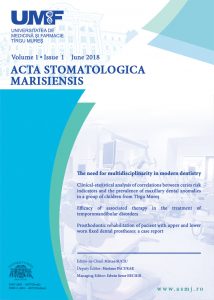The craniofacial skeleton in the growing child is responsive to changing functional demands and environmental factors. Orthopedic modification of facial bones through the application of constant forces over long periods of time has been a mainstay of orthodontic and dentofacial orthopedic therapy.
Aim of the study
The aim of this study was to evaluate changes in pharyngeal structures after rapid palatal expansion (RPE) and compare them with those after using a removable mandibular advancement device (MAD).
Material and methods
In order to accomplish function we modified the pattern of neuromuscular activity throught mandible forward position.
Results
This finding shows that maxillary deficiency and mandibular retrognathism have been reportedly linked to OSA as both etiologic factors and sequelae of prolonged mouth breathing during the period of growth, these illustrate the potential interaction between alteration in respiratory function and craniofacial morphology.
Conclusions
Craniofacial anatomic defects, including inferior displacement of the hyoid bone, larger gonial angle, smaller anterior cranial base, altered anterior and posterior facial heights, and mandibular deficiency, have been suggested as predisposing factors for upper airway obstruction during sleep. Cephalometry has been used extensively in the fields of orthodontics and anthropology to record craniofacial form. Recently, it has been also suggested that cephalometry could be an adjunctive procedure for assessing craniofacial patterns associated with OSAS.
Estimating efficacy of rapid maxillary expansion and mandibular advanced in the treatment of paediatric SDB. This might provide alternatives to primary treatments and/or enhance interdisciplinary treatment planning for the children suffering from OSA. The relationships between maxillofacial malocclusions and upper airway volumes were investigated. Literature studies on the association of upper airway narrowing with dento-skeletal malocclusions have been confirmed by us for the group of patients studied.
Mariana Păcurar 1, Eugen Bud 1, Silvia Pop 1, Manuela Chibelean 1, Martha Krisztina 1
1 George Emil Palade University of Medicine, Pharmacy, Science, and Technology of Targu Mures, Romania
1 George Emil Palade University of Medicine, Pharmacy, Science, and Technology of Targu Mures, Romania

Comments are closed.